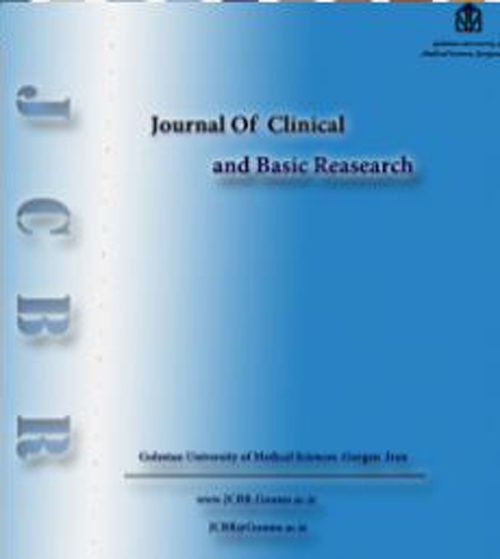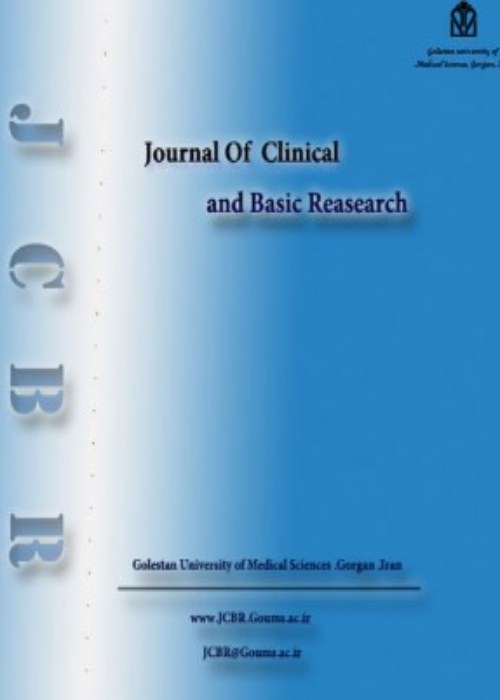فهرست مطالب

Journal of Clinical and Basic Research
Volume:6 Issue: 2, Spring 2022
- تاریخ انتشار: 1401/06/07
- تعداد عناوین: 5
-
Pages 1-11Background and objectives
Cancer stem cells (CSCs) may contribute to tumor initiation, distant metastasis, and chemo-resistance. Quaking (QKI) is a RNA binding protein, a tumor suppressor, and a well-known stem cell biomarker in central nervous system (CNS) cancer. The aim of this study was to identify the potential of QKI mRNA as a prognostic marker for CNS cancer.
MethodsThe Cancer Genome Atlas (TCGA) was investigated for gene expression profile within CNS cancer data. Further analysis was done through cBioPortal and COSMIC to explore the QKI gene mutation(s). Moreover, QKI mRNA levels were evaluated by using SAGE Genie tools. The Kaplan-Meier Plotter was utilized to identify prognostic role of QKI mRNA levels in these cancers.
ResultsHigher levels of QKI mRNA were detected in brain cancer tissues. Altered QKI gene expression was observed in 2% (56/2,958) of patients. Missense QKI gene mutation rate was 35.29%. The QKI gene alterations led to deleterious amino acid changes, including P181R, Q112P, and A220G. Altered QKI gene expression was significantly correlated with reduced survival rate (p<0.05).
ConclusionThe QKI gene is most expressed in brain tissues. In patients with gliomas, altered QKI expression/mutation is associated with a shorter survival rate. The findings of this study indicate that the QKI gene mutations can be considered as a potential prognostic biomarker for brain malignancies.
Keywords: Quaking, Biomarker, The Cancer Genome Atlas, neural inflammation disorders -
Pages 12-20Background and objectives
Pregnancy-induced hypertension (PIH) is a serious pregnancy complication that contributes significantly to both maternal and neonatal morbidity and mortality. The study aimed to evaluate various hematological parameters associated with PIH and to identify early hematological parameters predictive of eclampsia and hemolysis, elevated liver enzymes, and low platelet count (HELLP) syndrome.
MethodsA total of 114 subjects were studied. Venous blood samples were collected to study hematological profile, including coagulation and biochemical analysis.
ResultsOf 114 subjects, 35 were categorized as gestational hypertension, 33 as mild preeclampsia, 40 as severe preeclampsia, and six as eclampsia. Eight cases progressed to HELLP syndrome. The mean hemoglobin level was 10.6+2.1 g/dl, which decreased significantly in PIH patients as the disease progressed (p=0.045). The mean platelet count was 191 + 84 x 109cells/L. The mean platelet count in PIH patients decreased significantly with disease progression (p=0.008). The mean prothrombin time and activated partial thromboplastin time were 13.12 + 1.33 and 33.62 + 6.34 seconds, respectively. These parameters also increased significantly with disease progression (p<0.05). Liver enzymes, creatinine, and uric acid levels increased significantly as the disease progressed (p<0.05).
ConclusionMost of the hematological parameters changed as PIH progressed in severity. The mean levels of hemoglobin, platelet, and lymphocytes are lower in cases with PIH, while the mean prothrombin time and activated partial thromboplastin time are higher in these patients. These variables are sensitive and specific prognostic markers for patients with PIH.
Keywords: Pregnancy induced hypertension, thrombocytopenia, coagulation profile, HELLP syndrome -
Pages 21-30Background and objectives
Major β-thalassemia refers to a severe form of β-thalassemia in which, patients need blood transfusions from an early age. Iron overload is an important and long-term complication of repeated blood transfusions. The lungs are one of the sites of iron deposition; therefore, it is essential to investigate lung dysfunction due to iron deposition. This study evaluates pulmonary function tests in β-thalassemia major patients receiving regular blood transfusions and chelation therapy.
MethodsIn this cross-sectional descriptive study, 120 patients (68 males and 52 females) with β-thalassemia major aged 6 to 41 years who underwent blood transfusion at Bahrami Children's Hospital (Tehran, Iran) in 2021 were enrolled. The patients underwent hematological and pulmonary function tests on the day of transfusion. Association between pulmonary function tests and demographic and laboratory data was investigated.
ResultsSpirometry indices including forced expiratory volume in the first second (FEV1), forced vital capacity (FVC), and forced expiratory volume to forced vital capacity ratio (FEV1/FVC) were 86.14%±9.9, 87.86%±11.19, and 98.78%±10.97, respectively. In this study, the percentages of FEV1 and FEV1/FVC of patients older than 23 years were significantly lower compared to patients younger than 23 years. Moreover, a significantly lower FEV1/FVC ratio was seen in patients with higher body mass index and a serum ferritin level above 3,325 ng/dl. The most common impairment (19%) was a restrictive pattern.
ConclusionAge is inversely associated with FEV1 and FEV1/FVC ratio. Moreover, higher body mass index and serum ferritin levels are significantly associated with reduced FEV1/FVC ratio.
Keywords: Thalassemia, Respiratory Function Tests, Blood Transfusion, Iron Overload -
Pages 31-35
Sickle cell disease(SCD) is a hemoglobinopathy characterized by chronic hemolyticanemia and vaso-occlusive painful crisis. The vascular occlusion in SCD is a complex process that is responsible for most clinical manifestations of the disease. Abdominal pain is an important component of vaso-occlusive painful crisis and may mimic diseases, such as acute appendicitis and cholecystitis. Acute pancreatitis is rarely encountered as a cause of abdominal pain in patients with SCD. Gallstones and alcohol abuse account for the majority of the cases of acute pancreatitis. Pancreatic ischemia is an uncommon but established cause of pancreatitis associated with connective tissue diseases, vasculitis, and shock. In SCD, the deformed red blood cellsresulting from deoxygenation during stress, infection or dehydration, cause vaso-occlusion, tissue ischemia, and infarction. We present a case of SCDpresenting as acute pancreatitis apparently due to microvascular occlusion and ischemic injury to the pancreas. The patient responded to conservative management. Our case will help to always keep in mind and consider acute pancreatitis as a differential diagnosis in patients with SCD presenting with abdominal pain.
Keywords: Acute pancreatitis, Sickle cell disease, vaso-occlusive painful crisis -
Pages 36-44Background and objectives
Electrosurgical units produce the highest level of surgical smoke. Therefore, the present study aimed to determine concentration of surgical smoke compounds produced in orthopedic surgeries.
MethodsThe present study was performed on 20 patients in the operating room units of 5 Azar Hospital in Gorgan, Iran. Twenty smoke specimens were collected from electrosurgical units during orthopedic surgeries. The concentration of benzene, toluene, ethylbenzene, and xylene (BTEX) was determined using an air-sampling pump and SKC charcoal sorbent tubes. The collected data were analyzed using frequency distribution as well as generalized linear and ranked logistic regression tests in SPSS software (version 17).
ResultsMost patients had a body mass index (BMI) level of >24 kg/m2. The mean age of patients was 25.28 years. The average concentrations of benzene, toluene, ethylbenzene, and xylene were 540 µg/m3, 430 µg/m3, and 340µg/m3, and 390µg/m3, respectively. The concentration of particles with an aerodynamic diameter of 2.5 μm or less (PM2.5) was 22.75 µg/m3. Benzene values were higher than the National Institute for Occupational Safety and Health limit. The PM2.5 values were unhealthy for sensitive groups according to the Air Quality Index. Moreover, BMI had a significant association with the amount of benzene produced intraoperatively (p=0.016). The findings also showed that the surgery duration had a significant association with toluene production (p=0.049).
ConclusionThe concentration of BTEX compounds was low, but the PM2.5 values are high in the studied operating rooms. Long-term exposure to BTEX compounds can be considered as a health risk for operating room personnel.
Keywords: Electrosurgery, Smoke, BMI, PM2.5, BTEX


